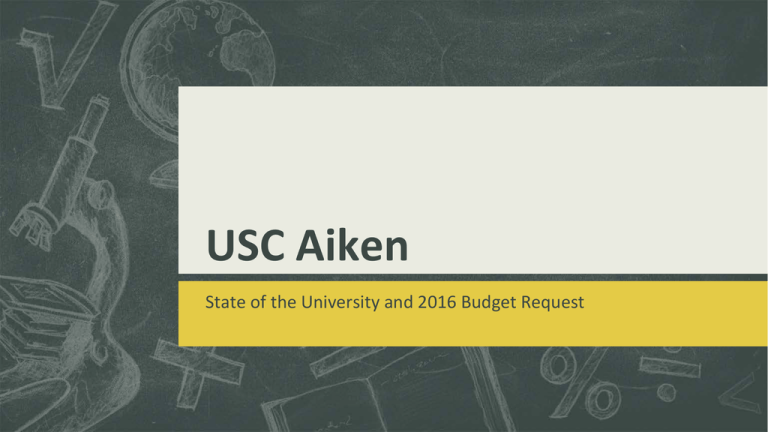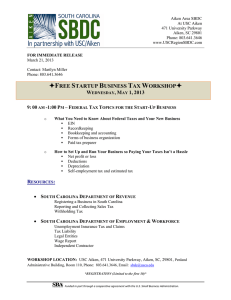Document 10787866
advertisement

USC Aiken State of the University and 2016 Budget Request USC Aiken’s “Forward Together” Goals Goal 1: Provide dis>nc>ve, high quality educa>onal experiences Goal 2: Enroll, retain develop and graduate a diverse student body Goal 3: Develop and manage resources effec>vely, efficiently and ethically to support the mission Goal 4: Create collabora>ve partnerships and innova>ve solu>ons to advance our community, region, and state. Significant Ques>ons for the Ci>zens & Leadership of South Carolina…. Is USC Aiken providing an accessible and affordable educa>on? Are USC Aiken graduates well-­‐prepared for life and work? Are the region and the economy benefi>ng from USC Aiken? Does USC Aiken seek efficiencies and use their resources effec>vely? Is USC Aiken Accessible and Affordable? Is USC Aiken providing an accessible and affordable educa>on? ACCESS is Important! United States needs 20 million more college-­‐educated workers by 2025. A recent study* finds that of the 6.6 million jobs created since 2010, 2.9 million were “good jobs” (defined as jobs paying $53,000 or more, full-­‐Sme, with benefits such as reSrement and healthcare). Only 100,000 of those jobs were filled by people with less than a Bachelor’s degree. *Georgetown University, Center for EducaSon and the Workforce, 2015 Study Is USC Aiken providing an accessible and affordable educa>on? State of South Carolina: Between 2015 and 2030, South Carolina will produce approximately 555,884 new jobs from economic expansion. 52% will require a college educaSon. Workforce needs will outpace labor growth, resul>ng in a shortage of 44,010 workers for posi>ons requiring an associate’s 70,540 with bachelors degrees or higher.* degree, and Over the next five years, our CSRA region is projected to have more than 37,000+ job openings requiring workers with higher educa>on.** Sources: *Compe>ng Through Knowledge Report, 2015; **Regional Workforce Study, SRSCRO, 2015 Is USC Aiken providing an accessible and affordable educa>on? Is USC Aiken providing an accessible and affordable educa>on? Is USC Aiken providing an accessible and affordable educa>on? Newer technologies offer access to a more diverse student popula>on. Is USC Aiken providing an accessible and affordable educa>on? 10 public Comprehensive Universi>es in South Carolina similar to size and scope to USC Aiken. Only Francis Marion offers students an undergraduate educa>on at a Net Price lower than USC Aiken. However, note that FMU is funded at $4,171 per student while USCA is funded at $2718 per student. Is USC Aiken providing an accessible and affordable educa>on? Suppor>ng Student Ajainment through fund-­‐raising efforts! These dona>ons will fund scholarships to help more students access an affordable, high quality. Are USC Aiken students well-­‐prepared for life and work? Are USC Aiken Students well-­‐prepared for life and work? University of South Carolina Aiken (USCA) is a comprehensive liberal arts ins>tu>on commijed to ac>ve learning through excellence in teaching, faculty and student scholarship, research, crea>ve ac>vi>es, and service. Only Ins>tu>on in South Carolina designated as a COPLAC University COPLAC Members must meet and demonstrate high standards in the following: Rigorous Curriculum in the Sciences, Arts & Humani>es, Social Sciences, Behavioral Sciences, Mathema>cs, and Wellness. All students must pass a wri>ng porlolio before gradua>ng. Corporate CEO’s want graduates who are accomplished in the outcomes of a Liberal Arts and Sciences curriculum! Are USC Aiken Students well-­‐prepared for life and work? A Focus on Quality Student to Faculty Ra>o is 16:1 Na>onal Peer Group= 18:1 % of Faculty who hold Terminal Degrees 75.8% (2014-­‐15) 74.8% (2013-­‐14 73.9% (2012-­‐13) Are USC Aiken Students well-­‐prepared for life and work? Are USC Aiken Students well-­‐prepared for life and work? USC Aiken has been highly recognized and decorated for excellence in educa>on and received a variety of awards for work across several domains… Are USC Aiken Students well-­‐prepared for life and work? An Educa>on that Emphasizes: Cri>cal Thinking Internships Undergraduate Research Engagement Pedagogies Wri>ng Porlolio Reading Project Healthy Body/Minds/Habits Volunteering Involvement Are USC Aiken Students well-­‐prepared for life and work? And let’s not forget… USC Aiken has been Awarded #1 for public Regional Comprehensive Universi>es in the South by U.S. News and World Report 2016. More than any other public ins>tu>on in South Carolina! Are USC Aiken Students well-­‐prepared for life and work? Are USC Aiken Students well-­‐prepared for life and work? Club Sports College to Career & Leadership Programs Study Abroad and Intern Abroad Opportuni>es Environmental and Sustainability Programs Healthy 4 Life Program Are South Carolina’s people, communi>es and economy benefi>ng? Does USC Aiken seek efficiencies and use their resources effec>vely? CreaSng the Economic Engine by GraduaSng the Future Workforce Gradua>ng 500+ Students in High Demand Areas each Year: § Nursing § Educa>on 2012-­‐2015= 1604 graduates § Engineering § Business and Accoun>ng § Mathema>cs & Computer Sciences § Psychology § Science and Applied Sciences…and many more Are South Carolina’s people, communi>es and economy benefi>ng? Major Partner for YEA Program Life-­‐long learning Aiken’s Accredited Daycare Program Community access to intellectual capital Cardio Rehab Partner Youth Camps Leader in Veteran Support and Re-­‐entry Partner with SRNL Partner with The Mill to support new business Speakers Series Open to the Public Are South Carolina’s people, communi>es and economy benefi>ng? Are South Carolina’s people, communi>es and economy benefi>ng? Are South Carolina’s people, communi>es and economy benefi>ng? And, let’s not forget, USC Aiken pumps $180,000,000.00 ANNUALLY into the South Carolina Economy, most of which benefits Aiken and Aiken County.* *(conserva>ve es>mate from the Darla Moore School of Business, Economic Study, 2014) Does USC Aiken seek efficiencies and use their resources effec>vely? Does USC Aiken seek efficiencies and use their resources effec>vely? Does USC Aiken seek efficiencies and use their resources effec>vely? Addi>onal Enhancement our Revenue Streams: Family Fund: 92% of USC Aiken employees donate to our university and this past year, they donated $83,696. Grant wri>ng: Faculty and Staff write grants which help to fund student research and enhance teaching and learning opportuni>es. During the 2014-­‐2015 fiscal year this amounted to $1,758,099. Does USC Aiken seek efficiencies and use their resources effec>vely? Just shy of $1 Million in cost savings or avoidance in 3 years. USC Aiken Budget Request 2016-­‐17 THANKS TO OUR LOCAL DELEGATION, USC AIKEN HAS MADE PROGRESS TOWARD PARITY FUNDING…..THANK YOU!!! AFTER ALL, STUDENTS FROM OUR REGION DESERVE THE SAME SUPPORT AS STUDENTS AT OTHER STATE UNIVERSITIES! Does USC Aiken seek efficiencies and use their resources effec>vely? Parity allows more South Carolinians access to an excep>onal educa>on from a highly ranked, but affordable, public university! Budget Requests for 2016-­‐2017 Student Success Center in the Gregg-­‐Graniteville Library Provide opportunity to bring tutorial services, wri>ng lab, student support professionals, and collabora>ve learning pods together in one loca>on. Recurring $252,500 for Student Reten>on. This includes opera>ng and personnel for Professional Advising and Mentoring and Student Support Center Staffing. And in Capital Non-­‐Recurring: $ 8,500,000 to provide support for Library Renova>on to create space for a Learning Commons with enhanced Student Success Center (total cost $10M state, 1M private, $500,000 ins>tu>on.) Budget Requests for 2016-­‐2017 Penland AdministraSon Building HVAC System and Life Cycle Plant and Equipment Maintenance: Capital Non-­‐Recurring Requests: $ 4,000,000: To provide support for Penland Administra>on Building HVAC Replacement (originally a $5.25M project, but through value engineering, the university reduced cost.) $ 300,000: To provide support for Life Cycle Funding for Plant and Equipment Maintenance. (A total of $600,000; $300,000 state and $300,000 Match) Penland Administra>on Building, 1972 Budget Requests for 2017 Summary of Requests: Parity and Recurring Funding to Support Student Success: $ 952,500: New funding to provide South Carolinians greater access to a high quality but affordable university educa>on. Specifically, to support student success through advising programs, infrastructure enhancements, and reten>on ini>a>ves. $252,500: Specifically to support Personnel and ongoing Programming for Student Success Capital Non-­‐Recurring Requests: $ 4,000,000: To provide support for Penland Administra>on Building HVAC Replacement $ 8,500,000: To provide support for Library Renova>on/Learning Commons (A total of $10M; $8.5M state; $1M Private; and $500,000 Ins>tu>onal) $ 300,000: To provide support for Life Cycle Funding for Plant and Equipment Maintenance (A total of $600,000; $300,000 state and $300,000 Match) Special Topic: Understanding Gradua>on Rate Data Special Topic: Understanding Gradua>on Rates Gradua>on Rates….A Misleading Measure Currently Based on Integrated Postsecondary Educa>on Data System (IPEDS) which was created by Title IV of the Higher Educa>on Act of 1965 1965: Typical Students were “Tradi>onal” § Between ages 18-­‐21 Entered college right out of high school § Took a full class load (12-­‐15 hours) § Parents saved to pay for college § Students didn’t work or worked part >me § Average >me to degree-­‐ 4 years § Colleges were less diverse (age, race, ethnicity) § Rare to change majors or transfer to another ins>tu>on 2015: Typical Students are Not “Tradi>onal” § More diversity (age, race, ethnicity) § May enter out of high schools, out of military, ayer community college or technical college § Transfer is not uncommon § Students oyen enrolled part >me or minimum full >me § Students work part or full >me § Students rely more on scholarships, grants, aid, and loans § Average >me to degree-­‐5+ years § Change majors 3-­‐5 >mes before gradua>ng Gradua>on Rates….who is NOT included! Current way Gradua>on Rate is Calculated: Based on Data from the Integrated Postsecondary Educa>on Data System (IPEDS) Current Model -­‐ Who is Excluded: • • • • Transfer students not included Students who take a “dual credit” course in high school before coming to college Freshman who enter in spring Freshman who enter in fall, but take fewer than 12 hours credit Gradua>on Rate is made up of those students in the cohort who complete six years later. Students who are s>ll enrolled and making progress, and students who have transferred and awarded degrees are counted as “non completers.” And, those students s>ll enrolled and persis>ng beyond six years are counted as “non completers.” Why does it majer? The IPEDS Cohort Model produces unintended consequences: ü Encourages some universi>es to place admission emphasis on students who will complete. ü Seriously disadvantages most regional ins>tu>ons. ü Disadvantages those ins>tu>ons who are providing access and who successfully recruit a diverse student body. ü Disadvantages ins>tu>ons with “pre-­‐professional” programs designed for transfer (to reduce program duplica>on). ü Disadvantages ins>tu>ons in states with effec>ve transfer ar>cula>on. ACCES S A Bejer Idea! Success Rates Measure what is happening to all student cohorts: Full >me and part >me, those entering as freshman during any semester, and those transferring into and out of the ins>tu>on. Don’t discount those students who have not yet graduated in six years. Determine if they are s>ll progressing toward a degree. Thank you for your § support!!
